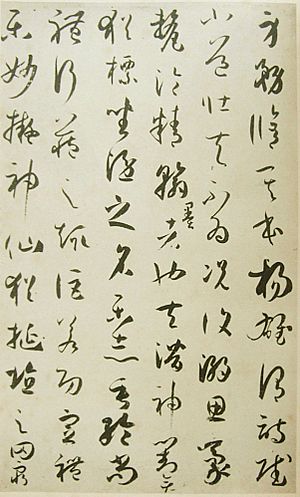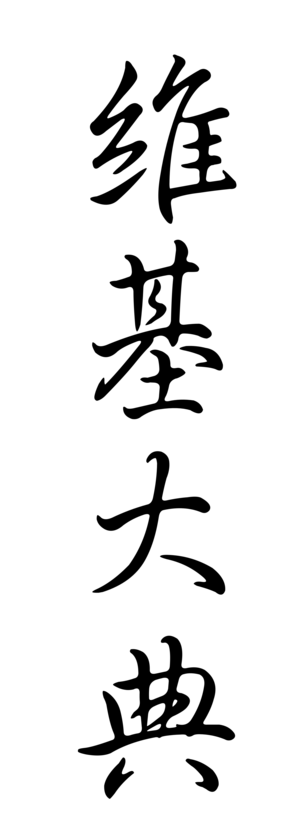Chinese character facts for kids

Chinese characters are special symbols used to write the Chinese and Japanese languages. Long ago, languages like Korean and Vietnamese also used them. These characters started at least 3,000 years ago. This makes them one of the oldest writing systems still used today.
In Chinese, they are called hanzi (汉字/漢字). This means "Han character." In Japanese, they are known as kanji, and in Korean, they are called hanja. Chinese characters are a big part of East Asian culture. Many people see them as a form of abstract art. This is because of how they are made with lines and dots. The art of writing Chinese characters beautifully is called calligraphy.
Contents
What Are Chinese Characters?
Chinese characters are a type of logogram. This means they mostly represent whole words or ideas. They do not usually represent just sounds, like letters in an alphabet.
Many early Chinese characters were pictographs. These were simple pictures that showed a thing or an idea. For example, a drawing of a sun meant "sun." Today, very few modern Chinese characters are simple pictures. Most are a combination of two or more simpler characters.
There are tens of thousands of Chinese characters. However, most are only slightly different from each other. They are often found only in very old texts. Studies in China show that people normally use about 3,000 to 4,000 characters every day.
How Characters Work
Chinese characters are a graphic language. This is very different from languages that use an alphabet, like English. To understand them, you need to learn each character's structure and meaning. Their meaning is closely linked to how they look.
For example, let's look at the character 房 (fáng). This character means "house." It is made of two parts:
- 户 (hù) means "door."
- 方 (fāng) gives the sound.
So, 房 (fáng) means "a person lives behind a door." The sound of 房 is "fáng" (with a rising tone). The sound of 方 is "fāng" (with a flat tone).
Chinese Characters in Other Languages
Many Chinese characters are still used in Japanese and Korean. In Japan, a person's education level is often judged by how many Chinese characters they know. In Korean, people sometimes use Chinese characters as notes in brackets. This happens when a meaning cannot be clearly said in Korean. Before the year 1446, Korean people only used Chinese characters for writing.
Other pages
- Simplified Chinese characters
- Traditional Chinese characters
- Wade-Giles, a system to write Chinese using the Roman alphabet
Images for kids
-
The Shi Qiang pan, a bronze bowl from around 900 BC. It has long writings about the first seven kings of the Zhou Dynasty.
-
A page from a Song dynasty book. The writing looks like the style of Ouyang Xun from the Tang Dynasty.
-
Chinese calligraphy by Song dynasty poet Mifu (1051–1108 AD). For many centuries, Chinese scholars were expected to be masters of calligraphy.
-
The character 次 in Simplified and Traditional Chinese, Japanese, and Korean. In Vietnamese: 次.
See also
 In Spanish: Caracteres chinos para niños
In Spanish: Caracteres chinos para niños












